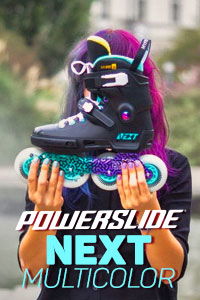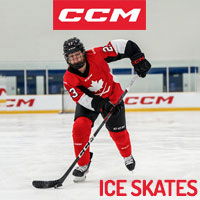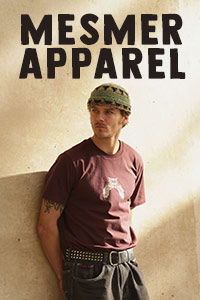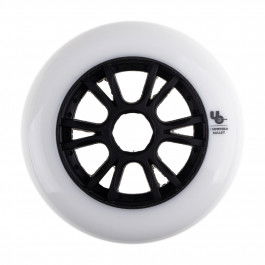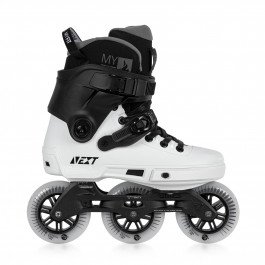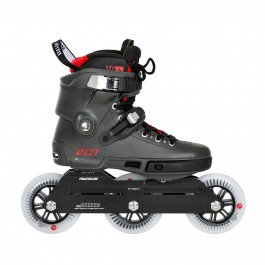My first reaction to release of Next 110 Charcoal skates and, in turn, the new Combat Rocker 110 frames was lukewarm. I knew that Powerslide is cooking them up for about a year (or possibly more, my memory is sketchy sometimes), I saw the pre-production designs, but they failed to capture my imagination in a way which would make me really curious about them. Mostly because I had a prior experience of skating 3 wheel frames with rockering and perceived it to be nothing more than a gimmick outside of freestyle slalom.
Things have changed when I had to write a product description of these skates. I’ve started to evaluate different options brought to the table by a more granular rockering thanks to use of hexagonal spacers. The fact that it is possible to shorten wheelbase just a little bit, tilt the skate to the front and give the front wheel a sub-2mm rocker seemed very cool.
Later that day, I’ve wrote an email to pals from Powerslide (the ones from Germany, not Polish distribution) that the idea they’ve came up with is really nice and for the first time I do think that rockering in triskates may actually make sense for urban skating. I liked the fact that new frames, according to specs sheet, were supposed to be 260 mm long, which isn’t far off from 255 mm 3x110 frames I’ve been skating for years and which were my favourite urban skating setup. I’ve shared my thoughts with Powerslide and received a response along the lines:
Would you like to get a pair of the skates to see what can be done with rockering for yourself?
Sulprus skates are always good, especially when they are Next, my favourite hardboot ever. I even came to conclusion, quite some time ago, that there’s no point for me to skate in anything else. Next fit my feet so good that every time I try different skates, they are a letdown in comparison.
The skates have arrived very quickly, but some time has passed until I got around to skating them, as I was on holidays with my family. When we got back home, I’ve put the skates on my feet the very same evening and wanted to go out and skate them right away. However, a problem has become clear as soon as I’ve get up and were standing with them on.
Make some noise!
New Combat Rocker use spacers made out of stainless steel. They fit very tightly in corresponding holes in frames, with low clearance. If you fail to put them into the hole with almost surgical precision, you won’t be able to tighten the axles all the way in. In turn, you’ll get insane amount of creaking and clicking noise caused by metal on metal play.
It will be present even while rolling slowly or shifting your weight from outer to inner wheel edges, while standing in place. Roll outside and it is very distracting. Therefore, it is absolutely necessary to take the pieces apart, clean any potential dust with dry, electrostatic cloth and carefully put them together. Less of an issue when buying frames separately (you need to put wheels in anyway) but to see this in a full setup is annoying. And yes, I have tightened the axles and other screws beforte first ride - problem was, the parts were not fitted with enough care in the first place.
After that procedure, I went for skating and for a while, creaking noise was gone. It has returned to some degree later on, but that's to be expected in any aluminium frames with metal spacers - nothing excessive, usual stuff.
Still, something was off.
The skates were turning horribly compared to my older setup with 255 mm frame. It is not possible for mere 5 mm to make such huge difference. I sat on a bench and started to wonder what is happening. For a while, I was thinking that maybe I've set the frames with a kind of anti-rocker, with middle wheel raised. This would explain lack of maneuverability – antirocker sucks for turning (and sucks out all of joy from skating, imo). But it wasn’t that. I took a closer look at the frames and noticed laser print – 290 mm.
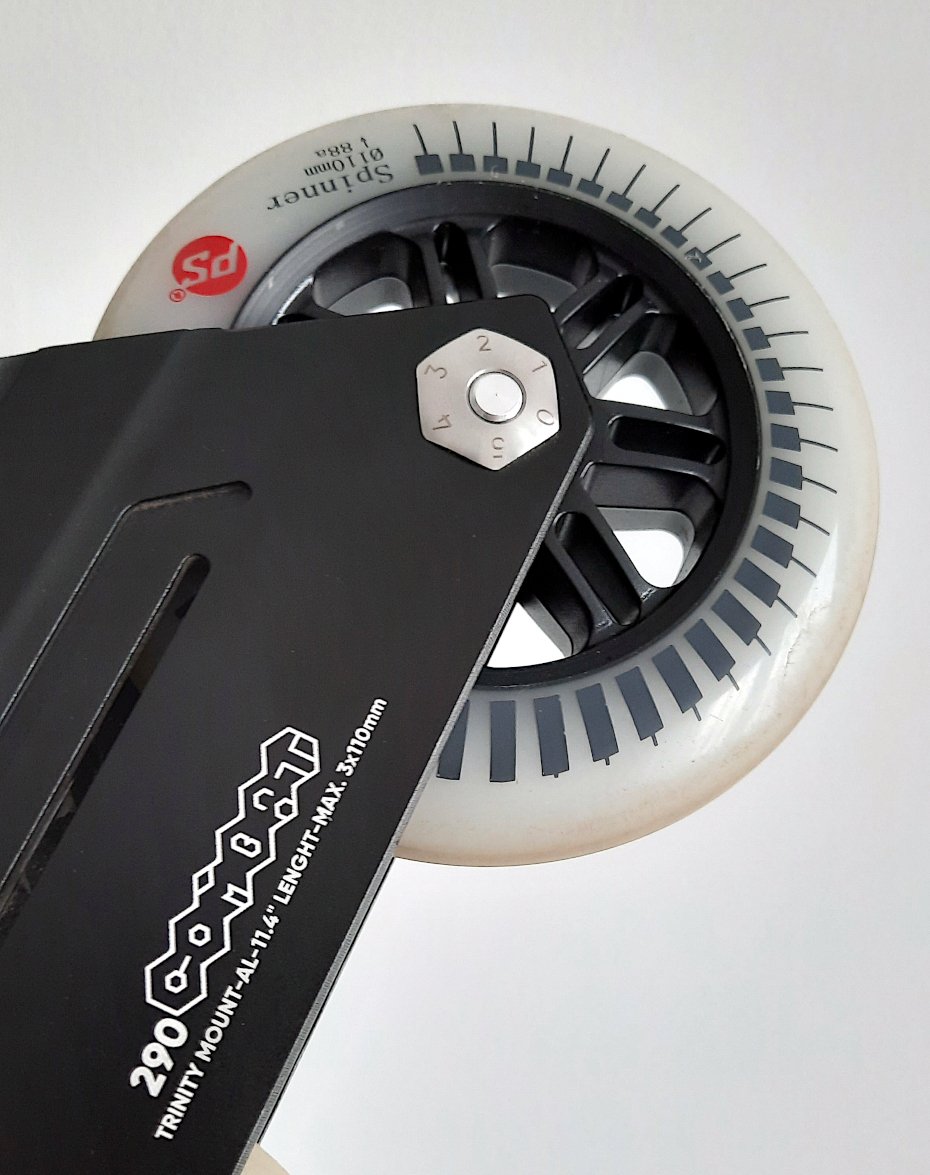
I got back home and measured wheel spacing, it was clearly 290 mm. I opened my laptop and checked Powerslide’s database for retailers. The skates had 260 mm frame length listed in specs sheet. I’ve also saw that both 260 mm and 290 mm frames are to be released separately, so I’ve dropped Powerslide an email, asking if my pair had 290 mm frames mounted by mistake, or if they have an error in their materials.
Answer came quickly and was something along the lines: Hi, thanks for pointing this out. Yes, these are supposed to come with 290 mm version, we now have corrected it on our end!
What’s not to like about Powerslide? :)
Thus, instead of getting a setup resembling the one I’ve already skated, but with rockering, I’ve received something I dare to call racing tanks. In my opinion, they fully deserve this nickname and perhaps surprisingly, it is a good thing. More on that later, but first, let me finish speaking about technical aspects.
The Germans go all in (and no, it’s not a pun about you know what and when)
I skate for 12 years now and during that time, had a lot of different setups with different frames. Some of those are really top notch gear, like the 255 mm Trinity Pro frames mentioned earlier or 243 mm Pleasure Tools which I no longer have.
However, when it comes to extruded aluminium frames, I’ve never skated anything like Combat Rocker – these are taking the top spot for me, easily outclassing everything else.
Powerslide didn’t held back. The brutalist aesthetics are very pleasing to the eye (at least for me) and frames themselves are engineering masterpieces. They use triple-void extrusion process, previously found only in highest end speedskating frames. Let me allow to explain what the hype is about.
Extrusion process used to make frames is basically pushing a heated metal through U shaped hole at extreme pressure. As it leaved the hole, it cools down and hardens. Then this aluminium profile gets passed for machining to remove excessive material, give it desired shape and finish.
If the hole have a simple U shape, the result are frames without any lateral bridges. This is called single-void extrusion. If there’s one additional lateral bar cut out, it’s double void. Two – triple void, which gives us not one, but two parallel levels of lateral bridges.
Thanks to two levels of lateral bridges connecting the frame walls, the rigidity of whole part is greatly improved and you can really feel it. Take out the wheels and Combat Rocker frames are still super rigid. I’ve never had a pair of stock frames giving as solid feel as those in my hands, ever.
Rockering which rocks.
The hexagonal spacers used for rockering are worth the praise, too. First of all – as mentioned earlier, these are made out of super hard stainless steel and when it comes to quality, they nuke ones used in Kizer Flux from orbit (earlier attempt at creating a big wheel frame with adjustable rockering).
Surprisingly, they use single piece, racing axles made out of 7075 grade aluminium alloy. One of spacers have hole for threaded end of the axle. This is genius solution – as aluminium is softer than stainless steel, the risk of damaging the thread in spacer itself is almost non-existent. The axle one will get damaged instead if you’ll mess something up, and these parts are cheap and easy to come by.
It is very important – the same axles are used in many different frames, but there’s no guarantee for how long Powerslide will be making spare spacers. At least as long as they’ll have Combat Rocker frames in their catalog, probably, but it is nice to know that frames are somewhat future-proof.
The high end, lightweight frames compensate for heavier spacers, but to be honest – the whole frames aren’t on a light side either, so it is hard to say how much perceivable difference they make.
A nice touch is the fact these spacers have numbered corners. This makes setting everything to your liking easy – just place the spacer on one side in desired position, see which number is facing upwards and replicate it on other side.
If you have a prior experience with K2 R100 frames, which also used hexagonal spacers, but without numbered corners and with double-piece axles, you’ll be relieved to know that configuring rocker here is much less of a hassle.
Hexagonal spacers are oriented in a way to give us four possible options height-wise, with two of them being placed slightly to left or right, depending on you preference. That’s downward, slightly raised, medium raised and upwards. In practice, you can adjust rockering in granular manner using three possible height differences between axles.
One doesn’t have to be a genius to realise abundance of options this brings to the table. When it comes to four wheel models, the obvious thing to do is to try a natural/wizard-like rocker, as it is achievable here. Still, you can opt for more extreme rockering or give the frames a bit of tilt to forward/backward.

We have covered how rockering works in Wizard-likes here, so if you want to learn more about benefits of this setup, absolutely read this piece. Copying the setup shouldn’t be hard. I fully expect that 4x Combat Rocker frames and skates which come with them will easily find audience without me going great lengths trying to advertise them.
I suspect that new Next 90 Charcoal will sell really well, considering that they cost only 50% more than most frames of this kind go for, alone. You get really solid boot, great liner and decent set of Spinner wheels for the asking price. Compared to rather crazy pricing of most alternatives, these seem like a steal.
The more interesting case are 3x versions and I dare to say, especially the 290 mm version which come stock on Next 110 Charcoal, as there is nothing like it on the market. Seeing that I skate them myself, I can give you first-hand impressions.
Pleasant surprise.
After discovering how long these frames truly are, I started wondering what to do with them. The stock, flat setup felt awful, giving that on-rails feeling. Furthermore, the frame felt less agile than longer, 318 mm Elite Casted MG 3x125 frame I also own. Why? The only explanation is superior rigidity of Combat Rocker. Elite Casted one is more flexible on ends and this makes it a bit more agile. I had no desire to skate the awful-feeling flat and decided to try rockering options.
My starting point was trying to shorten wheelbase a bit, by placing the axles closer together – first and last one, plus middle and last one. To achieve that, you need to place axles (starting with back of the frame) in 5-1-1 positions facing upwards. Honestly, there wasn’t that much of a difference.

Second thing was a classic front rocker – raising the wheel slightly was again not making much of a difference, but increasing the height did and it was promising. I felt that I am going somewhere with it.
When it comes to my classic triskating frames, I always rotate the wheels to have biggest one in the back and smallest one at the front, which gives boot a slight forward tilt and enforces a more dynamic skating stance. I thought that it would be good idea to try and emulate it using spacers, but also give it a moderate rocker at the front.
I’ve hit the jackpot. Setting the spacers in 3-2-0 positions facing upwards from back to front of the frame made me fall in love with these frames.
A different kind of magic.
To make something clear – if you are after frames for flowskating/wizard style, do not even consider getting triskating option, especially the longer version. Get ones made for four wheels and you’ll be happy.
What are the best words to describe the sensation of skating I get when using my pair of frames, rockered the way I’ve described above? Power, pure fire and rage.
I’m not going to lie, this kind of rocker doesn’t make the frame as agile, as shorter 255 mm one I’ve used before. I don’t even think it’s possible with 35 mm difference in length. Still, it makes it agile just enough to not give me any problems with adjusting when switching back and forth between skates.
Ever since my second kid was born, my time for skating has been limited. It is fair to say that I am not in as good shape physically as two years ago. But when I went for my usual “traditional” skating routine during which I come to city centre and then back home by two different routes, I’ve realised that I’ve managed to cut the time by about half an hour compared to what it took me previously. I do not know if it comes to equipment or a good mood it brought me, but one thing is for sure: the marriage of super solid, long Combat Rocker frames and durable Next hardboot feels amazing.
I’ve called these skates “racing tanks” because they are on the heavy side, you can feel that higher than average level of inertia on your feet. But on the other hand, you feel how energy put into every push translates into speed. Skating on flat ground, it is so easy to build up speed that you may feel like velociraptor (just do not bite people) or, if you are a vegan, an ostrich.
You go fast, think that’s already plenty of speed, but then you ask yourself – can I go faster? And yes, you can. And you still feel there’s potential to go even faster. When skating uphill, it feels like something is pulling you to the top. The only limiting factor is your body.

The frame length plays a huge role, even with rockered front wheel. I’ve never felt so confident when going downhill on triskates – level of stability is excellent and because you have that bit of rockering, taking corners is super easy even when going fast.
Jumps? I do not do huge gaps, but jumping off something, onto something, over something – the kind of things which come in handy in urban environment – feels good. The long wheelbase gives you advantage both when jumping and on landings.
In Next, I’ve found a boot which made me question if I even need any other skates, as they fit me so good. Combat Rocker 3x110 290 mm did the same when it comes to frames – as of now, I do not see the point of skating anything else, really.
Best of all? I am not using any fancy wheels. These are just regular, stock Spinners. Not bad wheels by any means, in my opinion these are kings of medium price tier, but they cannot really go against Undercovers or Hydrogens.
Pick a frame for yourself.
You can buy all five versions of Combat Rocker frames in our shop. I am happy to inform you that a person who designed these frames had a sensible viewpoint on what urban skating frames should be and abandoned nonsense pursuit of making the wheelbase as short as possible. Having just 1 mm of space between wheels doesn’t really make that much sense when you consider what freeskating is, especially with smaller wheels (or fewer of them) and wouldn’t be possible with this type of rockering anyway.
Super short frames pay off in freestyle slalom and inline hockey, but when it comes to freeride, the goal should be to achieve a good compromise between agility, stability and speed. The fact that some brands are making frames measuring about 230 mm and fitting 3x110 mm wheels looks like total misunderstanding of what urban skating is about.
The recent release of Sam Crofts' HC Evo freeskate comes with 260 mm Combat Rocker frame. Sam claims that he doesn't like super short wheelbase, so it was a perfect fit for him.
Below there’s a list of available frames, with some comments to make the choice easier (bear in mind availability may vary):
3x110, measuring 290 mm – covered in this article, nothing more to add. Beast of a frame, super solid and fast.
3x110, measuring 260 mm – should be a good pick for those with smaller boot sizes or preference of shorter frames in general. Also, if you've skated 243-255 mm long triskating frames before and want something close in feel, but with rockering - these are for you.
4x100, measuring 310 mm – main dish of entire line, geared towards people who are looking for fast, versatile big wheel frames which will perform in variety of scenarios: crusing, downhill and flowskating/wizard style.
4x90, measuring 291 mm – a good overall compromise between speed, setup height, stability and agility. Also a better choice than 4x100 version for those with smaller boot sizes.
4x80, measuring 260 mm – if you want frames with versatility of many rockering options, feeling close to regular 4x84 mm setup when it comes to length, these are for you
I’ll end this article with a side-note: I think it is possible to fit 125 mm wheels into 3x110 290 mm frames, maybe a certain way to setting the frame spacers will be needed.
Of course, you need Trinity-compatible boots to use these frames. I highly recommend Next which shouldn't come as a surprise to anyone who has been reading my thoughts on them in the past. If your feet are wider, Zoom skates are way to go. If you want something higher end, then Hardcore Evo and Tau are obvious choices. Then there are Next Charcoal 110 and Next Charcoal 90 coming with these as stock setups.



